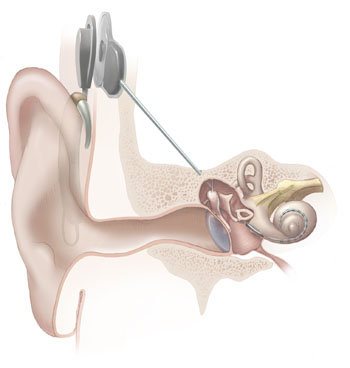
In a "hearing" ear, sound causes the ear drum to vibrate, which in turn vibrates the tiny bones in the middle ear. These vibrations move the fluid within the cochlear in the inner ear, and the flow moves against receptors (hairs) which fire electrical impulses up the auditory nerve to the brain. The sense of hearing is created by the brain's interpretation of these impulses.
Unlike a conventional hearing aid, a Cochlear Implant bypasses the eardrum, middle ear bones and cochlear hairs. Instead, and from within the cochlear itself, the implant produces the electrical impulses required by the auditory nerve.
According to Wikipedia:
"A cochlear implant (CI) is a surgically implanted electronic device that provides a sense of sound to a person who is profoundly deaf or severely hard of hearing.
Cochlear Implants may help provide hearing in patients that are deaf due to damage to sensory hair cells in their cochlea. In those patients, they can often enable sufficient hearing to allow better understanding of speech. The quality of sound is different from natural hearing, with less sound information being received and processed by the brain. However, many patients are able to hear and understand speech and environmental sounds. Newer devices and processing strategies allow recipients to hear better in noise, enjoy music, and even use their implant processors while swimming."
No comments:
Post a Comment